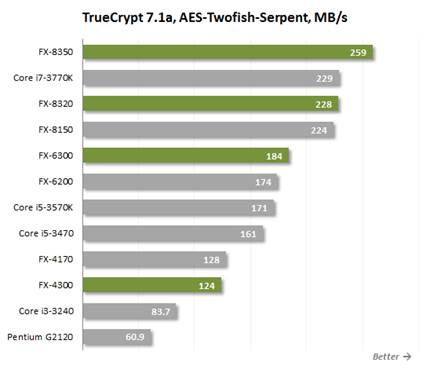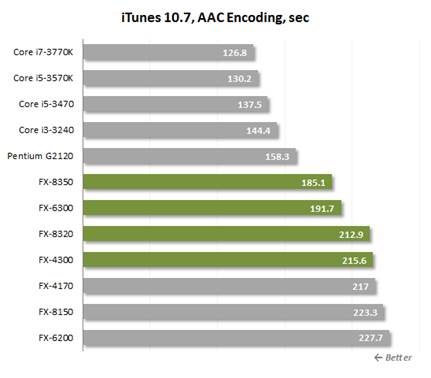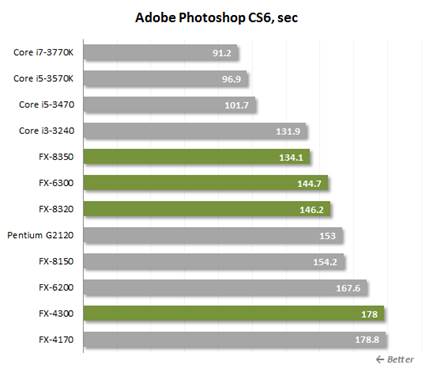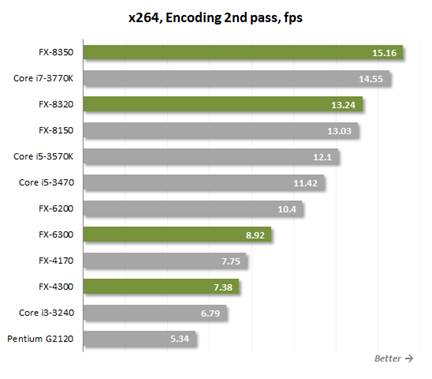App
performance
To judge the processors performance during
data storing, we used WinRAR archiving utility. Using the maximum compression
rate, we archived a folder with a lot of files with 1.1GB total size.

WinRAR
version 4.2
WinRAR version 4.2 is considerably
optimized for multi-threading, which is the reason why AMD FX processors do quite
well here. This is exactly why eight-core FX from Vishera generation is more
powerful than Core i5, and the six-core FX-6300 also starts keeping an eye on
it. However, the performance improvement we saw in Piledriver products didn’t
occur in FX-4300. Not only did AMD take away half of its cores, it also cut off
half of its L3 cache memory, making it defeated by FX-4170 and Core i3-3240.
The processor performance in encrypting
tasks is measured by using a benchmark of the well-known TrueCrypt utility which
uses AES-Twofish-Serpent “triple” encryption. I have to say that this utility
not only loads any number of cores plus works effectively, but also supports
the specific AES structure.

TrueCrypt
Encrypting task is a great way to discover the
AMD microarchitectures’ advantages. Here, FX-8350 works faster than the top LGA
1155 Intel Core i7-3770K, plus the FX-3820 with lower nominal clock speed falls
a bit behind it. The six-core and quad-core Piledriver processors also share
the success of their superior brothers. FX-6300 manages to win Core i5-3570K,
while FX-4300 leaves its rival, Core i3 CPU, far behind. At the same time, new
microarchitecture is not the primary contribution to this success. FX-8320 is
only 2% faster than FX-8150 meanwhile FX-6300 is 5% ahead of FX-6200, and
FX-4300 is left behind FX-4170 in vain. In other words, the top Vishera CPU’s
15% performance advantage over the relative Zambezi processor, which we admired
during the first test period, appearing outstanding with the newest member of
the Piledriver FX series, should be thought sole to the enhanced clock
frequencies.
We used Apple iTunes utility to test the
speed of transcoding audio. Through this test we transcoded the contents of a
CD disk into AAC format. Note that this program’s special trait is the unique single-threaded
load.

Apple
iTunes
Pitifully, contemporary Socket AM3+
processors didn’t offer us good performance under single-threaded load. The
weakness of Bulldozer cores (and now Piledriver ones) even pushed FX-8350
behind Pentium G2120. Vishera processors became a bit faster than their
predecessors, but it changed nothing in the global scale.
The eighth version of the famous scientific
Mathematica software suite is now ready; we decided to bring it back as one of
our frequent benchmarks. We used MathematicaMark8 integrated in this suite to
test the systems performance:

Wolfram
Mathematica 8
Wolfram Mathematica 8 is not another instance
of an application where AMD products face trouble. We didn’t deal with
single-threaded load here, but the FX processor microarchitecture’s features resulted
in great failure again. Current AMD processors only have one FPU per each
dual-core module, leading to low performance when processing floating-point
numbers.
We measured the performance in Adobe
Photoshop CS6 by using our own benchmark created from Retouch Artists Photoshop
Speed Test which was creatively customized. It includes typical editors of 24MP
images from a digital camera.

Adobe
Photoshop
AMD FX processors couldn’t boast about high
performance results in Adobe Photoshop. With no resource-consuming filters, but
throughout the typical versatile image process, eight-core and six-core FX
processors on Piledriver microarchitecture turned out slower than the dual-core
Core i3-3240. Though, this can still be considered an achievement, as the
previous generation FX processors were even defeated by Pentium G2120.
We also carried out some tests in Adobe
Photoshop Lightroom 4.2 program. The test case included post-processing and
exporting into JPEG format of two hundred 12MP images in RAW format.

Adobe
Lightroom knows the image-processing well
Adobe Lightroom knows how to process photos
using multiple threads, which immediately affects the results and improves AMD
FX numbers. Although different Vishera models are 16% faster than their Zambezi
predecessors, they still aren’t as good as Core i5 on Ivy Bridge. The junior FX
from the new generation even is left behind FX-4170, which once again shows
that cutting half of L3 cache was obviously a bad idea for FX-4300.
The performance in Adobe Premiere Pro CS6 was
determined by the time it took to create a Blu-ray project with a HDV 1080p25 video
into H.264 format and apply different special effects onto it.

HD
video processing
HD content processing is one of the best
types of load for multi-core AMD processors. In addition, the new Piledriver
microarchitecture works really well in such applications. Vishera is 21% better
than Zambezi in the same tests, which contributes 12% to the average. As a
result, FX-8350 runs more effectively than Core i5-3570K, FX-8320 almost
reached the level of Core i5-3470, and FX-6300 and FX-4300 proudly outperformed
Intel’s dual-core Ivy Bridge offerings, including the ones supporting
Hyper-Threading.
With a purpose of measuring how fast our
testing participants could transcode a video into H.264 format, we used x264 HD
Benchmark 5.0. It runs with an original MPEG-2 machine recorded in 1080p
resolution with 20 Mbps bitrate. I have to say that the results of this test had
great practical value, as the x264 codec is also a part of many well-known
transcoding utilities, such as HandBrake, MeGUI, VirtualDub…

Transcoding
video
HD video transcoding is an AMD-friendly
task. We could easily see it from the performance numbers proved by the FX-8000
series. They proved able rival not only Core i5, but also the flagship LGA 1155
Core i7-3770K. However, high performance of the top Vishera processors via
multi-threaded load is not typically simple models. Noting, FX-6300 is 70%
behind FX-8350 while FX-4300 is even slower than half of the eight-core CPU’s
speed. Hence, the six-core and quad-core Socket AM3+ processors couldn’t get
close to the junior Core i5. They can only try challenging Intel Core i3.
We would like to test computational
performance and rendering speeds in Autodesk 3ds max 2011 with the special
SPECapc for 3ds max 2011 benchmark:

Computing

Rendering
Rendering is another instance of a
multi-threaded task, where AMD processors can show off their strengths. New
Piledriver microarchitecture did fairly well here. As a result, FX-8350
outperformed FX-8150 by 20% and was faster than Core i5-3570K. FX-8320 with
lower clock speeds was only 6% faster than FX-8150, yet it is more than enough
for this processor to find its way into boxes of Core i5 Ivy Bridge CPUs. The
six-core FX-6300 was 12% faster than the previous generation FX-6200, but it was
left remarkably behind Core i5 series. As for the quad-core FX-4300, its
performance is equivalent to that of the FX-4170, placing it at the level of
Intel Core i3.